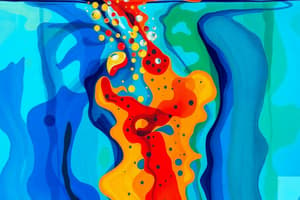Podcast
Questions and Answers
What is a drawback of the Solar Disinfection (SODIS) method?
What is a drawback of the Solar Disinfection (SODIS) method?
- Fast purification speed
- Limited capacity (correct)
- High cost
- Short processing times
Which chemical is commonly used in water treatment for disinfection purposes?
Which chemical is commonly used in water treatment for disinfection purposes?
- Chlorine (correct)
- Bleach
- Lemon juice
- Vinegar
What type of substances are added to water in chemical treatment to neutralize or eliminate contaminants?
What type of substances are added to water in chemical treatment to neutralize or eliminate contaminants?
- Metals
- Minerals
- Chemicals (correct)
- Plastics
In chemical treatment, what do corrosion inhibitors aim to protect?
In chemical treatment, what do corrosion inhibitors aim to protect?
What is the purpose of softening agents like soda ash in water treatment?
What is the purpose of softening agents like soda ash in water treatment?
What is the primary purpose of water purification processes?
What is the primary purpose of water purification processes?
Which filtration method uses a mixture of sand and clay to trap impurities?
Which filtration method uses a mixture of sand and clay to trap impurities?
What is a limitation of personal filter straws as mentioned in the text?
What is a limitation of personal filter straws as mentioned in the text?
Which filtration method involves pedal-driven units for rapid purification?
Which filtration method involves pedal-driven units for rapid purification?
What is a common concern related to ceramic filters according to the text?
What is a common concern related to ceramic filters according to the text?
Why might bicycle-powered systems be considered less favorable compared to other filtration methods?
Why might bicycle-powered systems be considered less favorable compared to other filtration methods?
Flashcards are hidden until you start studying
Study Notes
Water purification refers to the process of removing unwanted substances from contaminated water. This requires several methods aimed at eliminating contaminants like bacteria, protozoa, parasites, organic and inorganic compounds, and suspended solids. Two primary techniques are filtration and chemical treatment.
Filtration Methods
Filtration can involve simple mechanical processes used in homes or sophisticated technology employed in larger-scale operations. Common filtration types include ceramic, bicycle-powered, personal filter straws, and SODIS (Solar Disinfection).
Ceramic Filters
These passive devices use a mixture of sand and clay to create tiny pores that trap impurities, making them effective against bacteria and protozoa. However, they require regular maintenance to avoid breaking down quickly and need thorough cleaning to prevent recontamination.
Bicycle-Powered Systems
Such systems filter water through pedal-driven filtration units, offering rapid purification suitable for various purposes like cooking, cleaning, and drinking. While convenient, they tend to be expensive compared to other options and may not meet all water quality requirements.
Personal Filter Straws
Small, portable devices that filter pathogens from water, these straws are useful for emergency situations but have limitations in terms of lifespan and versatility. They focus primarily on drinking water purification without addressing other potential contaminants.
Solar Disinfection (SODIS)
This method utilizes clear plastic bottles exposed to direct sunlight's UV rays to kill germs, viruses, and parasites. Despite its simplicity and low cost, SODIS has drawbacks such as slow purification speed, limited capacity, and long processing times.
Chemical Treatment
Chemical treatment involves adding specific substances to the water to neutralize or eliminate contaminants. Commonly used chemicals include chlorine for disinfection and corrosion inhibitors for pipe protection. Other methods include softening agents like soda ash to counteract hard water minerals.
While each purification technique has its merits and challenges, advances in green and sustainable technologies continue to improve the efficiency and effectiveness of both filtration and chemical treatment approaches, ultimately aiming towards providing clean water for all.
Studying That Suits You
Use AI to generate personalized quizzes and flashcards to suit your learning preferences.




